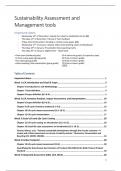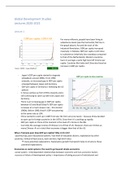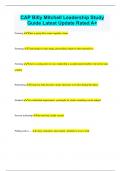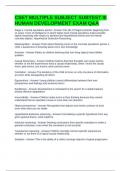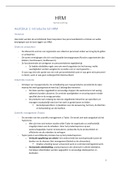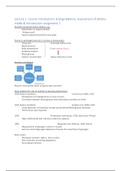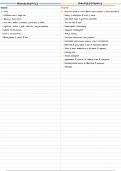Typically, something goes wrong every 10 years → examples: (a) elephant man trial, whereby
hands and ears swelled up in the early phases of clinical trials (first exposure to humans), and
some people had multiple organ failure → (b) fatal french study, whereby the endocannabinoid
system reacted to a drug in early drug trials, with six men hospitalised.
→ companies are done when something goes really wrong → high cost, high risk, but potentially
high profit industry → drug prices are often ridiculously increased (sometimes even 300%)
without good arguments.
Historically, companies needed only one blockbuster drug to stay alive, but recently, companies
often have to go into mergers and collaborations, because their blockbuster drug is out of its
patent life or a new drug failed → companies now need two main products to survive.
→ BUT, when companies don’t have interesting new drugs in the pipeline, they are unlikely to get
bought by another company → then they have to buy a company themselves or get sold in parts.
→ no other industry where the failure rate is as high in combination with such a high
investments as in pharma → problem: to improve health standards, we need new and innovative
products on the market → the risks are also compensated for by governments through patents
and reductions in development time (vaccines in half a year).
Drug development output: quality of life gets more and more important in drug development →
difference between:
- effectiveness: how well is a drug working? → FEX. in treating headache, how much is the
headache reduced, 40%, 50%, 60%?.
- efficacy: does it do what we want it to do, does it work? → FEX. does a product reduce
headache if it is intended to?
- efficiency: how fast does the drug work? how easy is a drug to use? → FEX. treating an
allergy, same efficacy, but one drug takes away the allergic reaction in less time.
- safety: always an outcome of a trial → how tolerable side-effects are depends on the
disease → FEX. hair loss is not tolerable for treating headaches, but is for cancer.
Me-too product = a product that does the same thing as another existing product and has no
further benefit, but just wants a piece of the market share → should not make it to the market.
→ drug development race = often multiple companies are developing similar things, so who is
first to the market? → if someone is first, your development is useless → speed of development is
not only in public health interest, but a huge commercial aspect is involved.
Aim drug development: getting a drug to the market, which gives the scientific proof of a
products’ effectiveness, efficacy, efficiency and safety → market approval depends on European
Medicine Agency (EMA) and European Economic Area (EEA), and national authorities (College ter
Beoordeling van Geneeskunde in NL) → BUT, also have to convince the government to get it
reimbursed (otherwise it cannot be used) → looks at other markets (real-world evidence of the
use of a product) and off-label use = use of a product that is not yet approved, but can be used
outside of research → important that it gets published.
Clinical trial = (a) one step in the drug development process, (b) involving human subjects, (c) to
investigate new methods of preventing, diagnosing or treating a disease.
→ are mostly interventional trials (commercial) = subjects undergo procedures other than usual
practice → sometimes observational trials (academic) = subjects are observed without
undergoing any interventions, according to usual practice (no drug administration).
→ involved parties:
, - Sponsor: takes responsibility for the trial, financing and outcome, but can get financing
from another party → oversees the organisation, protocols and publication of the results
(which is mandatory within a year) → NOT responsible for the quality of the data.
- sponsor R&D: monitoring/site management, data management, statistics, medical
writing, drug safety/pharmacovigilance (= detect, assess, understand and
prevent adverse effects of drugs), quality assurance, regulatory affairs.
- non-sponsor R&D: sales and marketing, medical department (supporting sales and
R&D), business departments (finance and legal).
- Investigator/site: takes responsibility for the quality of the data and determines whether
it leads to changes → NOT responsible for what happens to the output of the data (=
publishing, because they don’t own the data).
- Institutional Review Board (IRB)/Independent Ethics Committee (IEC): reviews the trials
to see if it is ethically responsible to keep doing the trials.
- Regulatory authorities/health authorities: government organisations, such as EMA,
Competent Authority (CA) within every EU country (Centrale Commissie Mensgebonden
Onderzoek (CCMO) in NL), Food and Drug Administration (FDA) in US, Pharmaceuticals
and Medical Devices Agency (PMDA) in Japan.
- Vendors: used for outsourcing trials (when a lot of people are necessary for performing
the trial) → FEX. Contract Research Organisation (CRO), Site Management Organisation
(SMO), central laboratory, Central ECG rading, Interactive Voice Response System (IVRS)
or Interactive Web Response System (IWRS) vendor (often to randomise trials), RNPS
services, tech vendors → have human resources as their product.
→ involved tasks: set objectives/hypothesis for the trial -> development
of protocols and other trial documents -> recruitment of subjects ->
management of the execution of a trial -> data analysis → steps:
(a) preparation: development/collection of essential documents, site
selection, obtaining IEC/CA approval, site initiation, report writing.
(b) execution: site management, routine
monitoring visits, updating essential
documents, report writing, query resolution,
close-out visits.
(c) analysis and reporting: administrative tasks,
filing, updating databases.
Clinical trial team: trial manager (leads the trial)
- clinical research associates (CRAs/monitors,
do data monitoring and site management) -
clinical trial administrators (CTAs/assistants,
administrative support) - line managers →
relationships: (picture left).
Lecture 2 - 10/01/2024 - Lifecycle of a Drug (I)
Clinical development is a highly regulated field → used to be a “free for all”, BUT regulations are
needed to balance public health and commercial interest (protect participants and patients).
Product development takes on average 12 years → options for earlier use: have people participate
in trials (clinicaltrials.gov used for registering clinical trials) -> patient provision (on a
case-by-case free-of-charge basis), which companies tell about on conferences to physicians
(they cannot advertise for it, because then it is marketing), for approved products that are under
, development OR not available in certain countries (physician needs to request the drug and
enable import license -> BUT, not likely to get import license if the drug is not approved).
Declaration of Helsinki = placebo use should be avoided, BUT regulators do not accept it → FEX.
with a drug for schizophrenia, the company did not want to give placebos, but the EMA
demanded placebo controls, so the company did a feasibility study and found out only Russia
would allow placebo controls, thereby they convinced the EMA to do it without.
Drug research: need to find a new chemical entity (NCE) or work with a known product → need
enough resources to mass produce it (can have ethical issues, FEX. if you need animals) → steps;
- in silico = biological-chemical tests using computer calculations -> big push towards in
silico to lower the number of animal tests.
- in vitro = testing in the lab with microorganisms, cells and biomolecules.
- in vivo = testing on at least two different species of living animals (pre-clinical testing).
- in humano = (clinical trials) always a risk of rejecting of a product that is not safe and
effective enough -> even if it is safer and better, it may not be used due to higher costs.
- phase I: test safety, determine safe dosage, identify side-effects, 20-80 patients ->
phase II: test effectiveness, evaluate safety 100-300 patients -> phase III: confirm
effectiveness, monitor side-effects, compare to other treatments, collect info,
1,000-3,000 patients -> phase IV: collect additional info after approval about
long-term risks, benefits and best use, 1,000+ patients.
Drug development: complex (laws and regulations, many disciplines/departments
involved), expensive, full of risks, short period for return on investment (ROI).
- aim drug development process: obtaining marketing authorisation
application (MAA), creating safe, efficacious, clean and reproducible
manufacturing → only 20% chance of a product making it to the market →
only 12% of drugs is approved for patients.
- trial cost: €900 million-2,5 billion per marketed drug, €1,5 million dollar
per day marketing delay, so pressure to have a drug developed → drug development
takes up to 20 years (patent life is short) → during development the patent is already
running → ROI is short; 10,000 compounds tested to get 1 on the market, about 10-15 get
tested on humans, >50% fail in phase I = about safety and finding the maximum tolerable
dose (MTD) (what dose can a human tolerate before side-effects are no longer
acceptable) → only 1 in 4 products recoups its own development cost → 1 in 100 is a
blockbuster (with more than €1 billion per year in sales).
→ stable market, because it is not influenced by economic crisis and geopolitics → BUT,
therefore also a lack of innovation, so unless pressure is put on the industry (by governments),
nothing will change → studies should be more patient-centric (patients should be involved).
- cost development: big failure with a drug development in 1964 led to Declaration of
Helsinki and regulations, which increased the cost of drug development → cost after
marketing (phase IV) are often lower, because the drug is already proven then.
- consequences increased costs: products licensing in/out, cooperative research,
co-development, co-marketing,
mergers and acquisitions.
- development time:
(pictures left).

